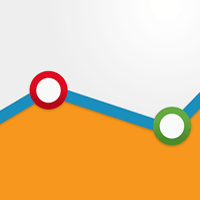Searching Behind the Curtain: Diving Deeper into Multi-Channel Analytics

Do you really know how your search marketing efforts directly impact your overall online initiatives and business goals? Are you confident that you are properly allocating your online marketing resources across channels?
For many marketers, it's not always crystal clear. Web analytics is definitely foundational, but measuring marketing metrics in narrow silos leads to missing valuable, big-picture insight that could change the way you invest your budget.
Overall business goals should serve as your destination, and the metrics and analytics can be viewed as the directions to help get you there. Without a good analytics strategy, you are essentially running aimlessly in the dark. When multiple channels are involved in your online marketing strategy, it is essential to ensure that all channels are working toward a common goal or set of goals - all paths leading to the final destination.
Even more important, it's not just about what you measure, but what you do with the data. When you clearly identify your goals and align all marketing channels, it's easier to see what's working, what's not, what areas need improvement, and quick fixes that can boost performance across channels.
To accomplish our ultimate business goals, the focus needs to move beyond simply counting clicks and their sources. Each lead and every source of traffic needs to be analyzed to see where to best spend our time and resources. This process involves taking our analytics data and weaving it into the very fiber of our business models.
DIVE DEEP DOWN THE FUNNEL
If you are only looking at clicks (number of clicks and/or the costper- click), time on-site, or on-site conversions (including cost-perlead or conversion rate metrics), it's time to evolve. Not all leads are created equal. Two leads might bear the same cost to acquire, but that doesn't mean they will perform equivalently well further down the sales funnel.
For example, one of our business-to-business clients was spending $110,000 per month with Google and other search engines, with its campaigns well-optimized based on cost-per-lead metrics. However, at the end of the day, many of the leads they received were unqualified. They didn't move further down the funnel into quotes and, ultimately, sales.
After a few changes to their metrics process - namely, implementing post-Web analytics by tying the data into its CRM to gain access to a deeper data set - we were able to move the focus down the sales funnel to the quotations-issued level. This simple step resulted in the release of 43 percent of previous AdWords and other search engine marketing spending. They were then able to reallocate that money to other marketing channels and online campaigns. At the same time, the company experienced a 21 percent lift in software sales from the remaining AdWords campaign.
This example highlights the fact that optimizing marketing efforts with analytics can be a great step toward more efficiently reaching the overall business goal. Additionally, with extra marketing dollars, this company was able to focus on optimizing other channels and revenue streams.
IMPLEMENTING POST-WEB ANALYTICS
Plenty of hype surrounds post-click analytics, but much of it is just that - hype. Savvy marketers have been looking at bounce rates, click paths, lead scoring and multiple conversion streams for several years now. What's far more exciting than post-click marketing is post-Web analytics.
This means integrating your Web analytics system into your sales force automation system (if you're working on generating leads) or into your CRM system and customer database if you're an ecommerce power. In other words, run your Web campaigns based on something more akin to the total expected lifetime value of a customer, rather than a guess on what a Web form or first ecommerce sale might be worth. In our experience, the clients we have taken just one step down the path of "post-Web" (for instance, managing Google campaigns on a keyword / category level to cost-per-qualified lead, rather than cost-per-web form), typically change the way they spend money online by as much as 45 percent.
Start by creating custom fields in your CRM system
(Salesforce.com, SugarCRM, etc.) for the information you want to capture. And remember, only measure what matters. Next, add hidden fields for each of these variables to all lead forms on your site. The hidden fields will pull information about the visitor from cookies, eliminating the need for you to ask the question, how did you hear about us? Of course, you will want to test all your forms to ensure the process is working and that they are easy to understand and be completed by your visitors.
Finally, process the data. Put the data captured from Web analytics into the custom CRM fields. You can then use this data to optimize paid search spend. Use it to integrate relevant keywords into your SEO efforts and optimize press releases. Also use it to determine the offers that your customers are most interested in, and then make sure you are offering the same thing across all channels.
USE ONLINE DATA TO INFORM MULTI-CHANNEL CAMPAIGNS
For many businesses, a great number of conversions happen in the real world, not online. Use what you learn online through your marketing and post-Web analytics strategy to inform offline campaigns. What works well in e-mail might also work with direct mail. Successful online video spots can be expanded into television ads. Do you get a lot of clicks on a particular banner ad? That eye-catching ad might make a good billboard or print advertisement.
Search is one of the most measureable marketing channels available, giving you invaluable insight into your customers' wants and needs. However, the sheer amount of data you can capture from search campaigns can sometimes be a pitfall for marketers who are overwhelmed by information overload. This is where goal-setting is so vital to the success of search analytics.
Paid search is perhaps the best online source to shape offline campaigns because it can help uncover the keywords and benefits that resonate most strongly with your target audiences. But it doesn't stop there. By keeping an eye on the origin of your clicks, you can even discover new audiences and sources for leads. Your ads might be getting clicks from a corner of the Web you never considered a part of your target audience. By exploring these sources you can then dig deeper and find the portals where that particular audience spends their time on the Web, even offline, thereby opening new channels of exposure for your brand.
One of the biggest advantages of today's online tools is the power to integrate multiple layers of data. By taking advantage of these systems you will find not only the channels that offer the best return on investment for your business, but entirely new areas of expansion and profit.
About the Author: A former McKinsey consultant and Dell veteran, Bill Leake draws on a deep expertise in both business and marketing to help increase revenues for a wide range of clients. He is the President and CEO of Apogee Search, one of the largest online marketing services firms in the United States.







